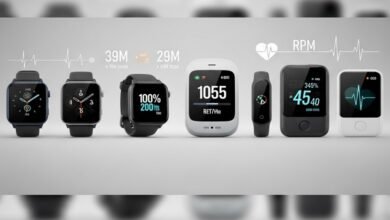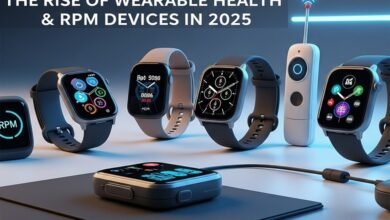Wearable Health & Remote Monitoring Devices – The Future of Personal Healthcare
In the last decade, technology has transformed how we live, work, and communicate—but perhaps one of the most exciting shifts is happening in healthcare. Wearable health and remote monitoring devices are no longer futuristic concepts; they are everyday tools empowering people to track their well-being in real time. From smartwatches measuring heart rate to advanced patches monitoring blood sugar levels, these innovations are redefining both preventive care and chronic condition management.
But are they really worth the investment? And how do they compare with traditional healthcare methods? Let’s break down the trends, reviews, and comparisons of these revolutionary devices.
🧠 What Are Wearable Health & Remote Monitoring Devices?
Wearable health tech includes gadgets like smartwatches, smart rings, patches, and biosensors that can continuously track health metrics. Remote monitoring devices take it a step further by transmitting data to healthcare providers, enabling doctors to monitor patients outside of clinics.
Examples include:
- 📱 Smartwatches & Fitness Bands (Apple Watch, Fitbit, Samsung Galaxy Watch).
- 💉 Continuous Glucose Monitors (CGMs) for diabetes management.
- 🫁 Respiratory & Cardiac Monitors for patients with chronic illnesses.
- 💍 Smart Rings (Oura, Ultrahuman) tracking sleep, recovery, and vital signs.
⚙️ Key Features & Functions
Most devices share some core features while offering specialized capabilities:
- ❤️ Heart Rate & ECG Tracking: Detecting irregular rhythms, stress levels, and heart health.
- 💤 Sleep Monitoring: Measuring REM, deep sleep, and overall rest quality.
- 🏃 Fitness Tracking: Steps, calories burned, and activity levels.
- 🩸 Blood Oxygen (SpO2) & Glucose Monitoring: Critical for respiratory and diabetic patients.
- 📡 Remote Data Sharing: Integration with healthcare apps and hospital dashboards.
These functions allow both everyday users and patients to gain better visibility into their health.
🌟 Benefits – Why Consumers Love Them
Wearable health devices are trending because they deliver control, convenience, and early intervention.
- ⏱️ Real-Time Insights: No more waiting for doctor’s visits to know what’s happening inside your body.
- 🩺 Preventive Care: Early detection of abnormalities like arrhythmias or oxygen drops.
- 🏠 At-Home Monitoring: Chronic patients save time and money by avoiding unnecessary hospital visits.
- 🧘 Lifestyle Motivation: Daily reminders to walk, hydrate, or rest encourage healthier routines.
- 🌍 Global Connectivity: Remote monitoring bridges gaps for patients in rural or underserved areas.
⚖️ Wearables vs. Traditional Monitoring
Traditional health check-ups rely on periodic visits, lab tests, and hospital equipment, which are accurate but not continuous. Wearables fill this gap by providing constant, low-cost insights, though sometimes with less medical-grade precision.
- 🏥 Traditional Care: More accurate, but episodic and reactive.
- ⌚ Wearables: Less clinical precision, but proactive and continuous.
👉 The best results often come when both approaches are combined—wearables for early signals, doctors for deeper diagnosis.
📈 Market Trends in 2025
Wearable health tech is at the center of healthcare innovation in 2025.
- 🧪 Medical-Grade Sensors: Devices like Abbott’s CGM or Withings ScanWatch now integrate FDA-cleared monitoring.
- 🌐 AI & Predictive Health: Algorithms analyze long-term data to predict risks before symptoms show.
- 📡 Telehealth Integration: Remote patient monitoring platforms sync with hospital systems for seamless care.
- ♻️ Eco-Friendly Wearables: Consumers prefer rechargeable, sustainable designs.
- 👵 Aging Population Demand: Seniors are adopting wearables to maintain independence and safety.
The pandemic accelerated adoption, and now these devices are mainstream health companions.
🔍 Popular Devices – A Quick Comparison
- Apple Watch Ultra & Series 9: Excellent for lifestyle + health with ECG, SpO2, and fall detection. Great all-rounder but battery life could be better.
- Fitbit Charge 6: Affordable, fitness-focused with reliable health metrics. Better for casual users.
- Oura Ring Gen 3: Discreet, stylish, and sleep-focused. Ideal for minimalists.
- Abbott Freestyle Libre (CGM): For diabetics, offers continuous glucose insights—life-changing for condition management.
- Withings ScanWatch: A hybrid watch combining medical accuracy with long battery life.
Each device has its strengths, and the right choice depends on whether you want fitness motivation, medical monitoring, or both.
✅ Pros & ❌ Cons of Wearable Health Devices
Pros:
✅ Real-time health insights.
✅ Supports preventive care and chronic condition management.
✅ Convenient, portable, and often stylish.
✅ Boosts motivation for a healthier lifestyle.
✅ Remote monitoring reduces hospital dependence.
Cons:
❌ Premium cost for advanced models.
❌ Data accuracy still lags behind clinical equipment.
❌ Privacy and data-sharing concerns.
❌ Requires consistent charging and app syncing.
👤 Who Should Use Them?
Wearable and remote monitoring devices are valuable for:
- 🏃 Fitness enthusiasts wanting progress tracking.
- 👵 Seniors seeking safety and independence.
- 🩺 Patients managing chronic diseases like diabetes or heart conditions.
- 👨👩👧 Everyday users aiming for healthier routines.
If you value prevention and convenience, these devices are worth considering.
🌟 Final Verdict – A Game-Changer in Modern Healthcare
Wearable health and remote monitoring devices have gone from fitness fads to healthcare essentials. While they may not replace doctors, they empower people to take control of their health daily and enable providers to offer smarter, faster care.
👉 In 2025, investing in a wearable is less about chasing trends and more about future-proofing your health. Whether you choose a smartwatch, a ring, or a medical-grade monitor, these devices are a bridge between personal wellness and professional care—a true game-changer in modern healthcare.



